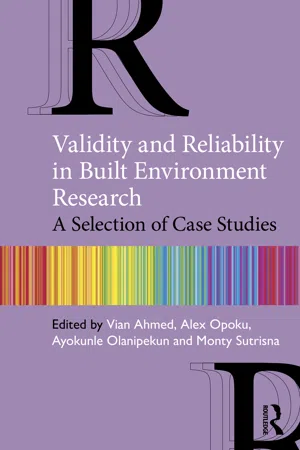
Validity and Reliability in Built Environment Research
A Selection of Case Studies
- 140 pages
- English
- ePUB (mobile friendly)
- Available on iOS & Android
Validity and Reliability in Built Environment Research
A Selection of Case Studies
About this book
This book aims to guide researchers who are engaged in social science and built environment research through the process of testing the reliability and validity of their research outputs following the application of different methods of data collection.
The book presents case studies that emphasize reliability and validity in different examples of qualitative, quantitative and mixed method data sets, as well as covering action research and grounded theory. The reader is guided through case studies that demonstrate:
- An understanding of the reliability and validity approaches from social science and built environment perspectives in alignment with the relevant research philosophies, approaches and data collection strategies
- Real research projects that have been conducted by expert researchers on topics such as Lean, BIM, Housing and Sustainability to answer specific or evolving questions in relation to the reliability and validity of research
- A simple and easy method that students at Masters and PhD levels can relate to in order to adopt a sound reliability and validity approach to their research
This book is the essential guide for researchers at undergraduate and postgraduate level who need to understand how to validate the quality of the empirical tests they conduct using different techniques. The book will also be a great asset to supervisors from different backgrounds who need a refresher on this key aspect of the research cycle.
Frequently asked questions
- Essential is ideal for learners and professionals who enjoy exploring a wide range of subjects. Access the Essential Library with 800,000+ trusted titles and best-sellers across business, personal growth, and the humanities. Includes unlimited reading time and Standard Read Aloud voice.
- Complete: Perfect for advanced learners and researchers needing full, unrestricted access. Unlock 1.4M+ books across hundreds of subjects, including academic and specialized titles. The Complete Plan also includes advanced features like Premium Read Aloud and Research Assistant.
Please note we cannot support devices running on iOS 13 and Android 7 or earlier. Learn more about using the app.
Information
Part IResearch reliability and validity
1Understanding reliability in research
1.1 Measuring errors in research
1.2 Research reliability
Attributes | Description |
|---|---|
Stability | The consistency of results using an instrument with repeated testing |
Homogeneity (or internal consistency) | The extent to which all the items on a scale measure one construct |
Equivalence | Consistency among responses of multiple users of an instrument, or among alternate forms of an instrument |
Source: Heale et al. (2015) | |
1.2.1 Stability
1.2.1.1 Test-retest reliability method
The test-retest reliability refers to the temporal stability of test from one measurement session to another (Drost, 2011). It is obtained by administering the same test twice, or more over a period ranging from few weeks to months, on a group of individuals (respondents) (Mohajan, 2017) under similar circumstances (Heale & Twycross, 2015). The procedure is to administer the test to a group of respondents and then administer the same test to the same respondents later (Drost, 2011). Thereafter, a statistical comparison is made between participant's test scores (values) for each of the times they have completed it to provide an indication of the reliability of the instrument (Heale & Twycross, 2015). For example, construction workers may be asked to complete the same questionnaire about safety satisfaction twice in three months so that test results can be compared to assess stability of scores. The correlation coefficient calculated between two sets of data, and the higher the coefficient, the better the test-retest reliability (and stability).(Mohajan, 2017)
Domains | Test-retest reliability results (n = 50) |
|---|---|
Physical function (PF) | 0.801** |
Role limitation due to physical problems (RP) | 0.781** |
Bodily pain (BP) | 0.856** |
General health (GH) | 0.721** |
Vitality (VT) | 0.962** |
Social functioning (SF) | 0.841** |
Role limitation due to emotional problems (RE) | 0.78 |
Mental health (MH) | 0.793** |
**P < 0.01 Source: Qu et al. (2009) | |
1.2.1.2 Limitation
Test-retest reliability is defined by the correlation between scores (values) on the identical tests given at different times (Drost, 2011) and this leads to some limitations. For instance, when the interval between the first and second t...
Table of contents
- Cover Page
- Half-Title Page
- Title Page
- Copyright Page
- Contents
- List of illustrations
- Contributors
- Acknowledgements
- Introduction
- PART I Research reliability and validity
- PART II Reliability test: Research case study examples
- PART III Validity test: Research case study examples
- PART IV Other research reliability and validity approaches
- Index